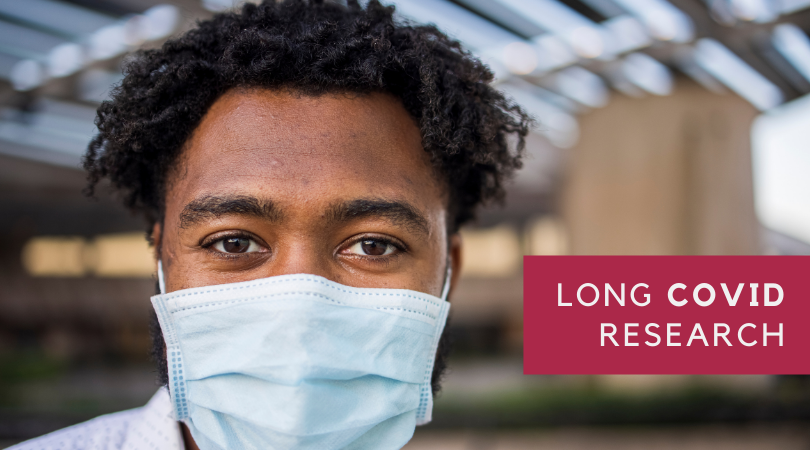Researchers Look for Causes and Treatments for Long COVID
Posted on
As the world begins to emerge from the pandemic and new coronavirus infections are on the decline, many people are still suffering the effects of long-haul COVID, a debilitating set of symptoms that has plagued patients and flummoxed the medical community.
 Symptoms of long COVID, which affects up to 30% of COVID survivors, include breathing problems, extreme fatigue, joint pain, cognitive issues, and heart palpitations, though scientists put all long COVID symptoms into three basic categories: exercise intolerance (in which any kind of exertion, even minor, causes extreme fatigue), dysautonomia (a dysfunction of the nerves that control involuntary function, which can cause dizziness and a racing heart) and the general cognitive problems described as “brain fog,” which can include mood changes, memory problems, and even suicidal thoughts.
Symptoms of long COVID, which affects up to 30% of COVID survivors, include breathing problems, extreme fatigue, joint pain, cognitive issues, and heart palpitations, though scientists put all long COVID symptoms into three basic categories: exercise intolerance (in which any kind of exertion, even minor, causes extreme fatigue), dysautonomia (a dysfunction of the nerves that control involuntary function, which can cause dizziness and a racing heart) and the general cognitive problems described as “brain fog,” which can include mood changes, memory problems, and even suicidal thoughts.
While the exact cause of long COVID is undetermined, researchers do have theories, and some of those theories explain why the cause of long COVID has been so difficult to pin down.
Potential Causes of Long COVID
Some researchers posit that long COVID is not a single condition, but rather a collection of different causes and reactions. It could have an autoimmune component that causes the body to attack itself, as with rheumatoid arthritis, lupus, fibromyalgia, and multiple sclerosis.
Another possibility is that vestiges of RNA and protein from the virus remain in the body even after recovery from the acute infection, causing the immune system to continue reacting, as is also thought to occur with chronic fatigue syndrome/myalgic encephalomyelitis.
Another clue comes from the fact that many people with long COVID report an improvement in symptoms after vaccination, either temporarily or permanently, which could indicate that some form of the full virus is still lurking in the body even after acute infection has passed.
There could even be a genetic cause, as one study showed that people with mutations affecting type I interferons are more likely to become severely ill when infected with COVID-19. Genetics also may be a factor in the small number of children (approximately 0.00009% according to the Centers for Disease Control and Prevention) who contract multisystem inflammatory syndrome after a COVID infection.
To help with the search, and in an acknowledgement of the seriousness (and realness) of the condition, the National Institutes of Health has dedicated $1.15 billion in funding to a research initiative on long COVID, which is officially called post-acute sequelae of SARS-CoV-2 infection (PASC). The NIH PASC Initiative will follow a group of long COVID patients to determine the underlying causes of PASC and identify possible treatments.
In another initiative, the Howard Hughes Medical Institute (HHMI) has granted $10 million to fund COVID-related research projects at Yale University, including one that focuses on finding causes and underlying conditions related to long COVID using new mouse models.
Researchers Use New Mouse Model to Study Long COVID
When the pandemic began, researchers used a mouse model that expresses human ACE2, a receptor that allows mice to become infected with the SARS-CoV-2 virus. That model was for severe COVID-19, however, and did not enable researchers to study milder infections.
Now, a slightly different mouse model, one that simulates a mild COVID-19 infection in the lungs but does not result in an acute infection, is enabling researchers to learn more about the possible causes of long COVID.
Using long COVID mouse models, a research team at Stanford University determined that even a mild COVID-19 infection can cause long-term cognitive issues and neurological damage. Once infected intranasally with COVID-19, the “mild COVID” mice showed no signs of sickness, and researchers confirmed that the virus was limited to the lungs and had not entered the brain.
Nevertheless, weeks after infection the mice showed high levels of cytokines in their cerebrospinal fluid and increased microglial activity in the subcortical white matter of the hippocampus, an essential region for learning and memory. Researchers also found a decrease in new neurons in the hippocampus after infection. New neurons help with brain repair and are important factors in learning, memory, and mood.
Another study at the Medical College of Georgia at Augusta University is using long COVID mouse models to get to the bottom of the temporary or lasting changes in taste or smell reported by about 80% of COVID patients.
COVID is known to attack organs including the lungs, heart, kidney, liver, and brain, which have the ACE2 receptors the COVID virus needs to gain access to cells, but whether ACE2 receptors are also found on the taste buds was less clear.
According to the Augusta University researchers, both ACE2 and TMPRSS2 molecules exist in significant levels in the taste buds of mice, which explains why the virus frequently affects taste. The team is doing further research to determine how exactly the virus changes the taste function, as well as what type of taste is affected and whether those changes can be reversed.
Research on long COVID continues, with the hope that these humanized “long COVID” mice will hold the key to understanding chronic COVID symptoms and lead to a solution that brings the millions affected by long-haul COVID some relief.